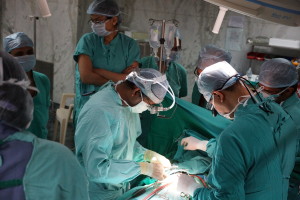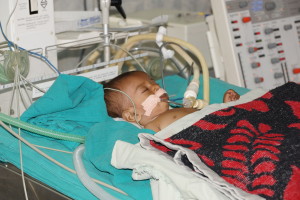Cardiac Surgical Procedures
The Department of Cardiothoracic and Vascular Surgery at Sri Sathya Sai Institute of Higher Medical Sciences offers a comprehensive range of cardiac surgical procedures, guided by the principles of compassion and excellence. These procedures are performed in accordance with the teachings and blessings of Sri Sathya Sai Baba, emphasizing the importance of selfless service to humanity.
Open Heart and Closed Heart Procedures
Cardiac surgery at SSSIHMS includes both open heart and closed heart procedures. Open heart procedures involve the use of a heart-lung machine, while closed heart procedures are performed without the need for such a machine. The Department’s expertise in both types of procedures ensures that patients receive the best possible care.
Common Open Heart Procedures
The commonest open heart procedures include coronary artery bypass surgery (CABG), valve replacements, aneurysm repairs, and correction of congenital heart defects. In SSSIHMS, a majority of coronary artery bypass procedures are performed without the use of a heart-lung machine, utilizing the Off Pump Coronary Artery Bypass (OPCAB) technique. Valve replacements are performed with repairs accomplished when feasible, and aortic aneurysms are treated according to their location, using valve conduits or grafts as indicated.
Closed Heart Procedures
Closed heart procedures include palliative and corrective surgeries for congenital heart defects. These procedures include PDA ligation, Bi-Directional Glenn, Blalock-Taussig shunt, Coarctation of Aorta repair, and others. The Department’s expertise in these procedures ensures that patients receive the best possible care.
Specific Procedures
The Department of CTVS at SSSIHMS offers a wide range of specific procedures, including:
– ALCAPA repair: A rare congenital anomaly where the Left Coronary Artery arises from the Pulmonary Artery instead of the Aorta. The procedure involves re-implanting the left coronary artery back to the ascending aorta.
– Aortic Root Replacement: A surgical procedure where both the aortic valve and the ascending aorta are replaced with artificial valve and graft, and the coronary buttons are re-implanted into the prosthetic graft.
– AP Window closure: A communication between the ascending aorta and the pulmonary artery is closed using a prosthetic or pericardial patch.
– ASD closure: A defect in the septum/partition between the left and right atria is surgically closed using a pericardial patch.
– AV canal repair: A complex defect where not only are the valves incompletely formed but also the atrial and/or ventricular septae/partitions are deficient. Repair involves not only repairing the two valves but also reconstituting the septae.
– AVR: Aortic Valve Replacement, where the Aortic valve is replaced with a prosthetic (mechanical) /bio-prosthetic (tissue) valve.
– BD Glenn: A procedure that improves blood flow to the lungs by connecting the Superior vena cava to the right pulmonary artery.
– Modified BT Shunt: A palliative procedure for many cyanotics with decreased pulmonary blood flow, Tetralogy of Fallot being the most common, where the subclavian artery is connected to the corresponding pulmonary artery using an appropriate sized artificial tube graft.
– CABG: Coronary Artery Bypass Graft, where blocked coronary arteries are bypassed using conduits from another part of the body.
– CoA Repair: A condition where there is a narrowing of the aorta, usually occurring in the proximal thoracic aorta section. The surgery involves removing the narrowed segment and connecting the two ends of the aorta directly whenever possible, or by placing a prosthetic graft between the two aortic segments.
– Cor Triatriatum repair: An abnormal membrane in the Left Atrium that divides the LA into two chambers. The membrane is surgically removed during this procedure.
– DCRV repair: Abnormal obstructing muscle bundles inside the Right ventricle are surgically removed.
– DORV repair: Double Outlet Right ventricle, where both the great arteries arise from the right ventricle. The repair involves closing the ventricular septal defect such that the left ventricle pumps blood into the aorta and the right ventricle into the main pulmonary artery.
– Fontan: A procedure for congenital heart diseases with a functionally single ventricle where the systemic venous return is directly sent to the pulmonary circulation.
– Lung resection: A procedure for removal of tumors and cysts in the lungs.
– MV Repair: Mitral Valve Repair, where the mitral valve is surgically repaired.
– MVR: Mitral Valve Replacement, where the Mitral valve is surgically replaced with a prosthetic (artificial) / bio-prosthetic (tissue) valve.
– Myxoma excision: A surgical procedure where a myxoma – a connective tissue tumor usually found in the heart chambers, is excised.
– PAPVC repair: Partial Anomalous Pulmonary Venous Connection repair, where one or more pulmonary veins drain into RA. Surgical correction involves closure of the associated ASD, routing the pulmonary vein/s to LA.
– PDA Ligation / Division: A procedure in which the Patent Ductus Arteriosus, a connection between the pulmonary artery and the aorta, is ligated (tied) or divided (cut).
– Pericardiectomy: A surgical procedure for the condition of Pericarditis involves removal of the adhered pericardium.
– RSOV repair: A condition where one of the cusps of aorta in the sinus of Valsalva ruptures into one of the right-sided chambers of the heart. Repair involves closure of the rupture.
– SAM Excision: Sub Aortic Membrane Excision is a surgical procedure on the aorta where a membrane below the aortic valve is obstructing the outflow of blood into the aorta.
– Supra Valvular Aortic Stenosis: Surgical repair of severe narrowing in the supra valvular portion of the ascending aorta.
– TAPVC repair: Total Anomalous Pulmonary Venous Connection repair, where all the pulmonary veins drain into RA instead of LA. Surgical correction involves routing them to LA.
– TGA: Transposition of Great Arteries, where the aorta arises from the right ventricle and the pulmonary artery from the left ventricle. Senning’s, Mustard are procedures at the atrial level, while Jatene’s is an arterial switch operation with coronary transfer.
– Thymectomy: A surgical treatment for the condition of Myasthenia Gravis involves excision of the thymus gland. This is also done for tumors of the Thymus.
– T.O.F Repair: A surgical procedure performed for the Tetralogy of Fallot condition, where the VSD is closed and the Right Ventricular Outflow Tract (RVOT) is reconstructed / augmented.
– VSD closure: Surgical closure of an abnormal opening in the septum/partition between the left and right ventricles.


